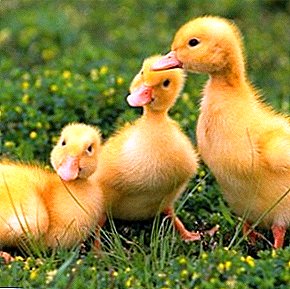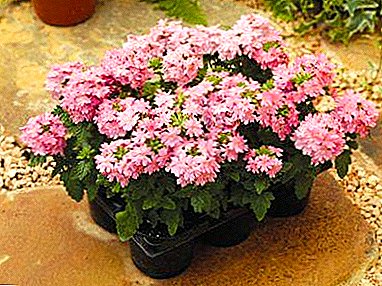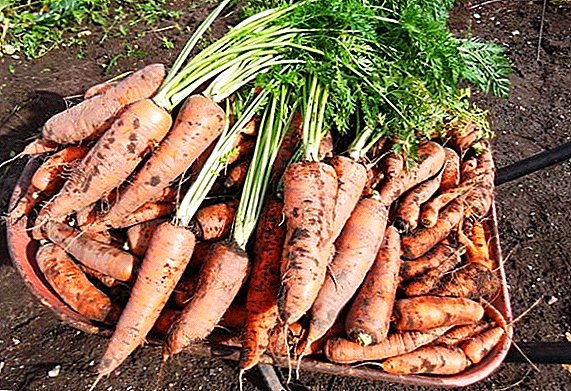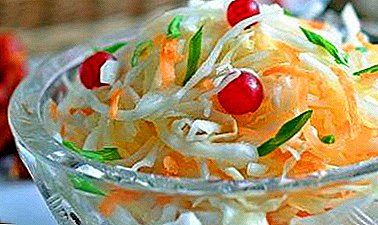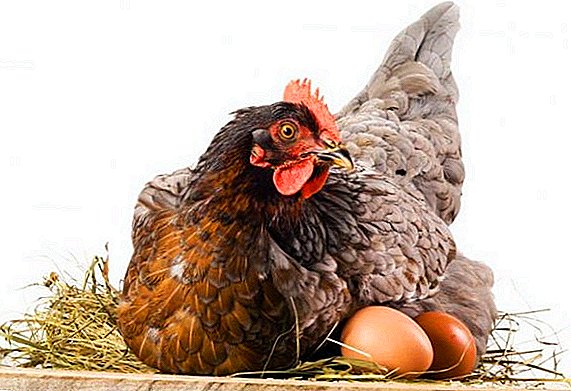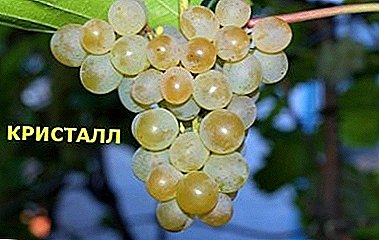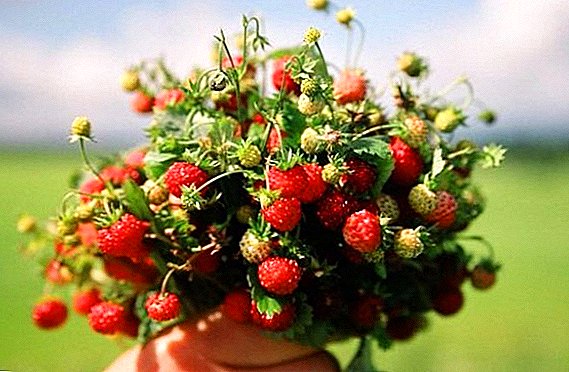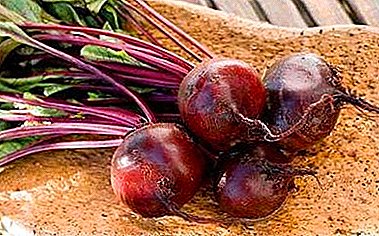
Beetroot is an indispensable product widely used in cooking, which is the source of most of the minerals and vitamins necessary for the body.
Currently, breeding methods have been developed varieties with a long shelf life, unpretentiousness and the most pleasant organoleptic properties, the most famous of which is the variety "Wodan".
The article describes this variety of beets and features of its cultivation.
Detailed characteristics and description of the variety
Beet "Vodan" F1 - a hybrid early ripe multi-edible table variety of amaranth culture with a growth period of three months. The ground part of the plant: the rosette is strong, pronouncedly developed, the tops are low, the leaves are directed straight up, richly maroon-malachite color.
Root crop rounded, with smooth edges and thin smooth skin. The root pulp is rich maroon, gives a lot of juice, with a characteristic sweetish taste and a weak beet aroma, has no rings and cores, is dense. The pulp has an increased water and trace element content. The average weight of a root crop varies from 200 to 500 grams, approximately identical fruits grow within the limits of one seeding.
The yield of beets without irrigation is 20-25 tons per hectare, with regular watering and fertilizing up to 50 tons per hectare.
We offer to watch a useful video about the characteristics of beet varieties "Wodan":
Breeding history
 This variety was bred by Dutch breeders at the end of the 20th century by creating specific provocative conditions conducive to the selection of plants with the desired properties (soil contamination, planting dates, temperature variation, feeding area, day length, etc.). After that, the hybridization method was used to combine the useful traits of parental forms in a hybrid variety.
This variety was bred by Dutch breeders at the end of the 20th century by creating specific provocative conditions conducive to the selection of plants with the desired properties (soil contamination, planting dates, temperature variation, feeding area, day length, etc.). After that, the hybridization method was used to combine the useful traits of parental forms in a hybrid variety.
As a result of the recombination, a variety with high germination, drought resistance, single seed, spherical shape and pleasant taste, as well as resistance to parasitic and microbial infections was obtained.
What is the difference from other types of buriak?
This variety has important advantages over other beet varieties.:
- Germination of 94%.
- High yield and early fruit ripening.
- Undemanding under cultivation and care, resistance to plant diseases.
- Lack of strelkovaniya and tsvetushnosti.
- Long storage at early crops without loss of flavoring and commodity qualities.
- Large size fruit.
Advantages and disadvantages
The variety has the following advantages:
- Resistant to most common plant pests.
- Germination more than ninety percent of the seeds.
- Pleasant organoleptic properties.
- Ease of care and storage.
- Resistance to adverse environmental conditions.
The following disadvantages are:
- Multi-growth.
- The need for certain properties of the soil and good lighting.
- The need to comply with the rules of crop rotation.
What and where is it used for?
The use of this table hybrid is widespread in cooking. Also, “Wodan” is grown on beam products and for short-term storage (up to six months).
Step by Step Growing Instructions
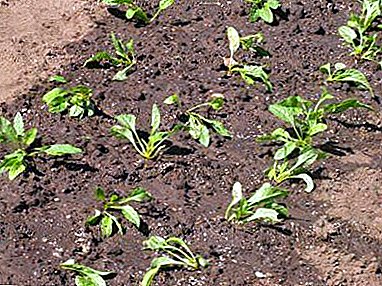 Where and for how much seed can be purchased? Seed material can be purchased directly in the gardening stores in Moscow and St. Petersburg, as well as ordered through the Internet. The average cost of seeds excluding delivery is 25.5 rubles and ranges from 20 to 31 rubles per 2 grams.
Where and for how much seed can be purchased? Seed material can be purchased directly in the gardening stores in Moscow and St. Petersburg, as well as ordered through the Internet. The average cost of seeds excluding delivery is 25.5 rubles and ranges from 20 to 31 rubles per 2 grams.- Landing time. The end of April - the beginning of May.
- Choosing a landing site. The plant belongs to the light-loving, the place for planting is recommended to be sunny, open. Optimal predecessors of this variety are cabbage, bulbous, legumes, umbrella. Do not plant beets after corn, cucumbers, tomatoes, potatoes.
- What should be the soil. Land for sowing should be loose and non-clay. Allowed loamy, sandy sand. The soil should not be acidic; if it is acidified, then wood ash, dolomite flour is added to it before planting.
Before sowing it is necessary to carry out soil treatment:
- Before autumn, the remains of plants are crushed, the territory is shelled with disc shelling plants for weed germination.
- After 3 weeks, plowing and destruction of sprouted weeds takes place.
- The soil is loosened to 30 centimeters.
- Harrowing and cultivation of the soil is recommended in the spring.
- Landing. It is recommended to prepare beds for beet in the fall or just before planting. The soil is dug up on half of the spade bayonet and leveled with a rake, getting rid of clods, stones, weeds. Sowing is performed in the soil grooves to a depth of 2.0-3.0 centimeters according to the scheme 6x30 cm.
Important! The first days after sowing the soil should be well moistened, after the formation of root crops watering rare. Germination in a week after sowing.
- Temperature. Sowing is possible in the temperature range of 11-16 degrees. The most optimal temperature for planting is 13 degrees.
- Watering. Watering is done once a week, immediately after watering, the soil is loosened and weeds are removed. Weeds that are not picked up on time attract a lot of pests to the site, and also cause a shortage of water and trace elements in the soil, worsening the growth of the crop.
- Top dressing.
To improve the growth of culture is recommended to conduct dressing.
Fertilizer application rate:
- 200 kg N / ha (in parts);
- 75 kg of P205 / ha;
- 250 kg K20 / ha;
- 100 kg of kieserite / ha.
 Other vegetable care measures. It is not recommended to soak the seeds of this variety, as they are treated for fungal infections with a specific fungicide that protects them from nematodes and other pests. Multi-growth culture necessitates the removal of weaker sprouts in order for the roots to be large.
Other vegetable care measures. It is not recommended to soak the seeds of this variety, as they are treated for fungal infections with a specific fungicide that protects them from nematodes and other pests. Multi-growth culture necessitates the removal of weaker sprouts in order for the roots to be large.A positive result is the mulching of the beds of last year's hay or mowed grass - this effectively prevents the evaporation of moisture and the growth of most weeds. With the rotting of the lower layer, additional nutrients enter the soil.
- Harvesting technique. Harvesting is carried out with the growth of root crops, not earlier than three months after planting. A month before the intended collection of watering stop. For cleaning choose a dry clear day. The heads are taken out of the soil with the help of a fork or pulling out for the tops.
- Crop storage. After digging out, the beets are left in the sun to dry, after which they clean the heads of soil residues, cut the leaves and send them to storage in a cool and dark room (basements with low humidity).
Diseases and pests
Beets of this variety have good resistance to plant diseases, since its seeds are pretreated. The disease can be defeated by the defeat of the roots because of the characteristics of the soil (typical of heavy, loamy soils and lowlands). Manifestations - thinning and rotting of the stem of the plant.
Prevention of various problems
In autumn, the acidic soil is neutralized with lime. For planting adhere to the rules of crop rotation.
The hybrid beetroot "Water" is the optimal beet crop for growing on the territory of Russia, because it has high germination and resistance to low temperatures and infections. Food and commodity quality varieties led to its rapid spread and popularization among gardeners.


 Where and for how much seed can be purchased? Seed material can be purchased directly in the gardening stores in Moscow and St. Petersburg, as well as ordered through the Internet. The average cost of seeds excluding delivery is 25.5 rubles and ranges from 20 to 31 rubles per 2 grams.
Where and for how much seed can be purchased? Seed material can be purchased directly in the gardening stores in Moscow and St. Petersburg, as well as ordered through the Internet. The average cost of seeds excluding delivery is 25.5 rubles and ranges from 20 to 31 rubles per 2 grams. Other vegetable care measures. It is not recommended to soak the seeds of this variety, as they are treated for fungal infections with a specific fungicide that protects them from nematodes and other pests. Multi-growth culture necessitates the removal of weaker sprouts in order for the roots to be large.
Other vegetable care measures. It is not recommended to soak the seeds of this variety, as they are treated for fungal infections with a specific fungicide that protects them from nematodes and other pests. Multi-growth culture necessitates the removal of weaker sprouts in order for the roots to be large.